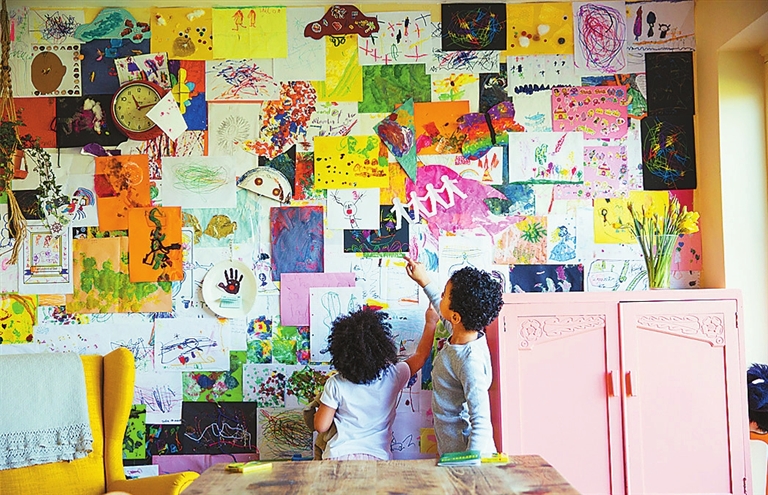
KIDS love paper. Cutting paper. Gluing paper. Drawing on paper. Tearing paper. Hanging paper. The mounds of art, scraps, and supplies can be overwhelming, and getting rid of them is not easy — not when even the tiniest doodle could be a treasure you think you’ll cherish dearly when your children grow up. But you can’t turn your house into a museum dedicated to your offsprings’ formative years. Creating an easy, manageable system to handle your kids’ paper projects is only the first step in reclaiming your buried dining room table, while still giving your kids a chance to explore and display their boundless creativity. A tidier space isn’t just good for the parents. Lorraine Falcone, a certified professional organizer and founder of home organizing service Naturally Organized, says putting things away is an opportunity to teach children to have a healthy relationship with “stuff,” and for them to learn why they shouldn’t keep everything they’ve ever made or owned. “You don’t need to have the item to remember the experience,” she says. If you’ve already let the paper clutter in your life get out of hand, don’t try tackling it all at once. Sarah Buckwalter, certified professional organizer and founder of Organizing Boston, recommends starting with one simple area. Clear the paper and projects off of the dining room table, or get school papers organized. You can also take a look at your kids’ art supplies drawer and get rid of dried-out markers, and small pieces of crayons; or sift through scraps to filter out the trash from what’s reusable. According to most experts, before you sort and categorize items for storage, first you need to declutter — get rid of everything you know you don’t want. That’s easy when it comes to old sporting gear in the garage, but it can mean making some difficult decisions when it comes to your children’s creations. If you find that decluttering is emotionally hard for you, then it may be helpful to sort and categorize first. Falcone says people should ask themselves why they want to keep a particular item. Many kids aren’t actually as sentimentally attached to their artwork as you might be, so keeping reams of paper to give to them when they’re adults may not make a lot of sense. Ultimately, there’s no one firm rule for decluttering things that hold a sentimental value. You need to decide what makes the most sense for you and your family. Kids are proud of their artwork and love to show it off. Giving them a dedicated space to exhibit their masterpieces is a good idea. Just make sure not to nourish a permanent collection. Falcone suggests displaying your kids’ projects just as if you were running a gallery — with rotating shows and defined timelines for how long each piece stays up. At the end of the exhibit, you can make an event of taking the art down together in preparation for the next one. Hanging up a string with a limited number of clothespins to hold paper is another way of imposing limits. Once there are no more pins left, the kids will have to decide what to take down if they want to hang something new up. If setting those boundaries is too hard, Buckwalter recommends giving the kids and yourself a memorabilia box where everyone can keep what’s important to them in the long term. Cull through that box once or twice a year — time and distance can make it easier to let go of old projects. One easy way to keep your kids’ crafts without having to physically store them is digitizing them. The simplest way to do this is to scan or photograph their creations and upload them to a cloud storage service. Then, you still want to be discerning about what you keep on the cloud — digital clutter is still clutter after all, and poses its own challenges. As good as it feels to have everything in its place, organization systems are only as good as your ability to maintain them — the easier it is, the more consistently you’ll use them. Ideally, this will not be a chore that only involves the adults in the home. Depending on their ages, try to include your kids as well, either as helpers, or as the sole keepers of the new order in the common areas of your house. Keep in mind your children’s personalities and integrate what they like into the organizing system you use. If they love color, color code things; if they love stickers, you can make creative labels, perhaps with pictures or drawings by your kids, to show what’s inside each container of their artwork. Another key element to keep in mind when designing your organizing system is access. Falcone recommends starting by keeping those items your kids will use the most front and center, along with crafts supplies like coloring paper, crayons, and washable markers. Items that you want to control access to, like paint, glue, glitter and scissors, should be kept out of reach for your little ones, but still easy for you to retrieve.(SD-Agencies) | 
